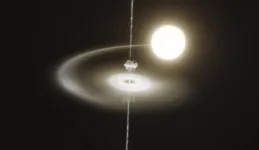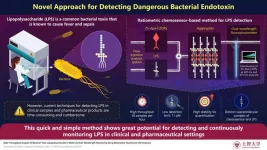(Press-News.org) With a remarkable observational campaign that involved 12 telescopes both on the ground and in space, including three European Southern Observatory (ESO) facilities, astronomers have uncovered the strange behaviour of a pulsar, a super-fast-spinning dead star. This mysterious object is known to switch between two brightness modes almost constantly, something that until now has been an enigma. But astronomers have now found that sudden ejections of matter from the pulsar over very short periods are responsible for the peculiar switches.
“We have witnessed extraordinary cosmic events where enormous amounts of matter, similar to cosmic cannonballs, are launched into space within a very brief time span of tens of seconds from a small, dense celestial object rotating at incredibly high speeds,” says Maria Cristina Baglio, researcher at New York University Abu Dhabi, affiliated with the Italian National Institute for Astrophysics (INAF), and the lead author of the paper published today in Astronomy & Astrophysics.
A pulsar is a fast-rotating, magnetic, dead star that emits a beam of electromagnetic radiation into space. As it rotates, this beam sweeps across the cosmos — much like a lighthouse beam scanning its surroundings — and is detected by astronomers as it intersects the line of sight to Earth. This makes the star appear to pulse in brightness as seen from our planet.
PSR J1023+0038, or J1023 for short, is a special type of pulsar with a bizarre behaviour. Located about 4500 light-years away in the Sextans constellation, it closely orbits another star. Over the past decade, the pulsar has been actively pulling matter off this companion, which accumulates in a disc around the pulsar and slowly falls towards it.
Since this process of accumulating matter began, the sweeping beam virtually vanished and the pulsar started incessantly switching between two modes. In the ‘high’ mode, the pulsar gives off bright X-rays, ultraviolet and visible light, while in the ‘low’ mode it’s dimmer at these frequencies and emits more radio waves. The pulsar can stay in each mode for several seconds or minutes, and then switch to the other mode in just a few seconds. This switching has thus far puzzled astronomers.
"Our unprecedented observing campaign to understand this pulsar’s behaviour involved a dozen cutting-edge ground-based and space-borne telescopes," says Francesco Coti Zelati, a researcher at the Institute of Space Sciences, Barcelona, Spain, and co-lead author of the paper. The campaign included ESO’s Very Large Telescope (VLT) and ESO’s New Technology Telescope (NTT), which detected visible and near-infrared light, as well as the Atacama Large Millimeter/submillimeter Array (ALMA), in which ESO is a partner. Over two nights in June 2021, they observed the system make over 280 switches between its high and low modes.
“We have discovered that the mode switching stems from an intricate interplay between the pulsar wind, a flow of high-energy particles blowing away from the pulsar, and matter flowing towards the pulsar,” says Coti Zelati, who is also affiliated with INAF.
In the low mode, matter flowing towards the pulsar is expelled in a narrow jet perpendicular to the disc. Gradually, this matter accumulates closer and closer to the pulsar and, as this happens, it is hit by the wind blowing from the pulsating star, causing the matter to heat up. The system is now in a high mode, glowing brightly in the X-ray, ultraviolet and visible light. Eventually, blobs of this hot matter are removed by the pulsar via the jet. With less hot matter in the disc, the system glows less brightly, switching back into the low mode.
While this discovery has unlocked the mystery of J1023’s strange behaviour, astronomers still have much to learn from studying this unique system and ESO’s telescopes will continue to help astronomers observe this peculiar pulsar. In particular, ESO’s Extremely Large Telescope (ELT), currently under construction in Chile, will offer an unprecedented view of J1023’s switching mechanisms. “The ELT will allow us to gain key insights into how the abundance, distribution, dynamics, and energetics of the inflowing matter around the pulsar are affected by the mode switching behavior,” concludes Sergio Campana, Research Director at the INAF Brera Observatory and coauthor of the study.
More information
This research was presented in a paper to appear in Astronomy & Astrophysics (doi:10.1051/0004-6361/202346418)
The team is composed of M. C. Baglio (Center for Astro, Particle, and Planetary Physics, New York University Abu Dhabi, UAE [NYU Abu Dhabi]; INAF – Osservatorio Astronomico di Brera, Merate, Italy [INAF Brera]), F. Coti Zelati (Institute of Space Sciences, Campus UAB, Barcelona, Spain [ICE–CSIC]; Institut d’Estudis Espacials de Catalunya (IEEC), Barcelona, Spain [IEEC]; INAF Brera), S. Campana (INAF Brera), G. Busquet (Departament de Física Quànticai Astrofísica, Universitat de Barcelona, Spain; Institut de Ciències del Cosmos, Universitat de Barcelona, Spain; IEEC), P. D’Avanzo (INAF Brera), S. Giarratana (INAF – Istituto di Radioastronomia, Bologna, Italy [INAF Bologna]; Department of Physics and Astronomy, University of Bologna, Italy [Bologna]), M. Giroletti (INAF Bologna; Bologna), F. Ambrosino (INAF – Osservatorio Astronomico di Roma, Rome, Italy [INAF Roma]); INAF – Istituto Astrofisica Planetologia Spaziali, Rome, Italy; Sapienza Università di Roma, Rome, Italy), S.Crespi (NYU Abu Dhabi), A. Miraval Zanon (Agenzia Spaziale Italiana, Rome, Italy; INAF Roma), X. Hou (Yunnan Observatories, Chinese Academy of Sciences, Kunming, China; Key Laboratory for the Structure and Evolution of Celestial Objects, Chinese Academy of Sciences, Kunming, China), D. Li (National Astronomical Observatories, Chinese Academy of Sciences, Beijing, China; University of Chinese Academy of Sciences, Beijing, China; Research Center for Intelligent Computing Platforms, Zhejiang Laboratory, Hangzhou, China), J. Li (CAS Key Laboratory for Research in Galaxies and Cosmology, Department of Astronomy, University of Science and Technology of China, Hefei, China; School of Astronomy and Space Science, University of Science and Technology of China, Hefei, China), P. Wang (Institute for Frontiers in Astronomy and Astrophysics, Beijing Normal University, Beijing, China), D. M. Russell (NYU Abu Dhabi), D. F. Torres (INAF Brera; IEEC; Institució Catalana de Recercai Estudis Avançats, Barcelona, Spain), K. Alabarta (NYU Abu Dhabi), P. Casella (INAF Roma), S. Covino (INAF Brera), D. M. Bramich (NYU Abu Dhabi; Division of Engineering, New York University Abu Dhabi, UAE), D. de Martino (INAF − Osservatorio Astronomico di Capodimonte, Napoli, Italy), M. Méndez (Kapteyn Astronomical Institute, University of Groningen, Groningen, The Netherlands), S. E. Motta (INAF Brera), A. Papitto (INAF Roma), P. Saikia (NYU Abu Dhabi), and F. Vincentelli (Instituto de Astrofísica de Canarias, Tenerife, Spain; Departamento de Astrofísica, Universidad de La Laguna, Tenerife, Spain).
The European Southern Observatory (ESO) enables scientists worldwide to discover the secrets of the Universe for the benefit of all. We design, build and operate world-class observatories on the ground — which astronomers use to tackle exciting questions and spread the fascination of astronomy — and promote international collaboration for astronomy. Established as an intergovernmental organisation in 1962, today ESO is supported by 16 Member States (Austria, Belgium, the Czech Republic, Denmark, France, Finland, Germany, Ireland, Italy, the Netherlands, Poland, Portugal, Spain, Sweden, Switzerland and the United Kingdom), along with the host state of Chile and with Australia as a Strategic Partner. ESO’s headquarters and its visitor centre and planetarium, the ESO Supernova, are located close to Munich in Germany, while the Chilean Atacama Desert, a marvellous place with unique conditions to observe the sky, hosts our telescopes. ESO operates three observing sites: La Silla, Paranal and Chajnantor. At Paranal, ESO operates the Very Large Telescope and its Very Large Telescope Interferometer, as well as survey telescopes such as VISTA. Also at Paranal ESO will host and operate the Cherenkov Telescope Array South, the world’s largest and most sensitive gamma-ray observatory. Together with international partners, ESO operates ALMA on Chajnantor, a facility that observes the skies in the millimetre and submillimetre range. At Cerro Armazones, near Paranal, we are building “the world’s biggest eye on the sky” — ESO’s Extremely Large Telescope. From our offices in Santiago, Chile we support our operations in the country and engage with Chilean partners and society.
The Atacama Large Millimeter/submillimeter Array (ALMA), an international astronomy facility, is a partnership of ESO, the U.S. National Science Foundation (NSF) and the National Institutes of Natural Sciences (NINS) of Japan in cooperation with the Republic of Chile. ALMA is funded by ESO on behalf of its Member States, by NSF in cooperation with the National Research Council of Canada (NRC) and the National Science and Technology Council (NSTC) in Taiwan and by NINS in cooperation with the Academia Sinica (AS) in Taiwan and the Korea Astronomy and Space Science Institute (KASI). ALMA construction and operations are led by ESO on behalf of its Member States; by the National Radio Astronomy Observatory (NRAO), managed by Associated Universities, Inc. (AUI), on behalf of North America; and by the National Astronomical Observatory of Japan (NAOJ) on behalf of East Asia. The Joint ALMA Observatory (JAO) provides the unified leadership and management of the construction, commissioning and operation of ALMA.
Links
Research paper
Photos of the VLT
Photos of ALMA
Photos of the NTT
Find out more about ESO's Extremely Large Telescope
For journalists: subscribe to receive our releases under embargo in your language
For scientists: got a story? Pitch your research
Contacts
Maria Cristina Baglio
New York University Abu Dhabi and Italian National Institute for Astrophysics (INAF)
Abu Dhabi, United Arab Emirates
Tel: +97126287089
Email: mcb19@nyu.edu ; maria.baglio@inaf.it
Francesco Coti Zelati
Institute of Space Sciences
Barcelona, Spain
Tel: (+34) 937379788 430416
Email: cotizelati@ice.csic.es
Sergio Campana
INAF Brera Observatory
Merate, Italy
Tel: +39 02 72320418
Email: sergio.campana@brera.inaf.it
Bárbara Ferreira
ESO Media Manager
Garching bei München, Germany
Tel: +49 89 3200 6670
Cell: +49 151 241 664 00
Email: press@eso.org
END
ESO telescopes help unravel pulsar puzzle
2023-08-30
ELSE PRESS RELEASES FROM THIS DATE:
Novel chemosensor-based method for rapid detection of bacterial toxin
2023-08-30
The COVID-19 pandemic made it very clear that we need better methods to quickly screen for dangerous pathogens and substances. One such compound that regularly flies under the radar is lipopolysaccharide (LPS), largely known as "endotoxins." This molecule, which is found in the outer membrane of Gram-negative bacteria, can be very harmful to humans. It can trigger a major immune response, producing fever and inflammation. In the worst cases, it can cause organ failure due to sepsis.
Surprisingly, for such a ubiquitously present toxin, there are very few ways to effectively detect the presence of LPS. The gold standard for its detection is the limulus amebocyte ...
How a mere 12% of Americans eat half the nation’s beef, creating significant health and environmental impacts
2023-08-30
A new study has found that 12% of Americans are responsible for eating half of all beef consumed on a given day, a finding that may help consumer groups and government agencies craft educational messaging around the negative health and environmental impacts of beef consumption.
Those 12% – most likely to be men or people between the ages of 50 and 65 – eat what researchers called a disproportionate amount of beef on a given day, a distinction based on the latest Dietary Guidelines for Americans, which suggest 4 ounces per day of meat, poultry, and eggs combined for those consuming 2200 ...
New research establishes enduring connection between racial segregation, childhood blood lead levels
2023-08-30
Living in a racially segregated neighborhood puts Black children at a higher risk of having elevated blood lead levels, and this association has persisted over more than two decades, according to new research from the Children’s Environmental Health Initiative, which is led by University of Illinois Chicago Chancellor Marie Lynn Miranda.
The study, published in Pediatrics, analyzed data from the early 1990s and from 2015 from blood lead level tests of more than 320,000 children younger than 7 in North Carolina. Researchers ...
Pandemic pushed half-million kids into grandparents’ homes
2023-08-30
PULLMAN, Wash. – Grandparents appeared to serve as an important private safety net when COVID-19 first hit the U.S., according to a study led by a Washington State University researcher.
The pandemic’s arrival in 2020 coincided with a surge of nearly 510,000 children living in “doubled-up” households, co-residing with other adults in addition to their parents or parents’ partners. While these living arrangements had already been increasing before COVID-19, this was an additional increase beyond what would be expected based on previous trends ...
Stress and insomnia linked to irregular heart rhythms after menopause
2023-08-30
Research Highlights:
A study of more than 83,000 questionnaires by women ages 50-79, found more than 25% developed irregular heart rhythms, known as atrial fibrillation, which may increase their risk for stroke and heart failure.
Stressful life events and insomnia were strongly linked to the development of atrial fibrillation, highlighting the need for mental well-being evaluations to be included with physical health examinations.
Embargoed until 4 a.m. CT/5 a.m. ET Wednesday, Aug. 30, 2023
DALLAS, Aug. 30, 2023 — After menopause an estimated 1 in 4 women may develop irregular heart rhythms — known as atrial fibrillation – ...
New principles for patient data use balance research benefits, individual privacy
2023-08-30
Statement highlights:
This statement emphasizes that policies for patient data sharing should be interpreted and applied respectfully toward patients and research participants, equitable in impact both in terms of risks and potential benefits, and beneficial across broad and demographically diverse communities in the United States.
The statement outlines six new principles focused on encouraging the generalizability of research advances, good stewardship across the translational spectrum, transparency, education and involvement of patients, access and privacy protections.
Embargoed until 4:00 ...
Blood cell insights offer potential boost to lung cancer therapies
2023-08-30
Fresh discoveries about a type of immune cells could give lung cancer patients a more accurate prognosis and better identify who will benefit from immunotherapies.
Researchers found that the location in and around tumours of cytotoxic T cells, which play a key role in fighting cancer, may help predict patient survival and indicate whether or not treatments will work.
The findings could help to pave the way for improved immunotherapies - powerful but expensive life-extending treatments which currently fail in 80 per cent of cases - allowing them to work more effectively in more patients, researchers say.
Experts ...
Climate extremes hit stressed economies even harder
2023-08-30
"The unprecedented societal interruptions during the Covid-19 pandemic of 2020 and onward took their toll on economic activity. Lockdowns disrupted supply chains and caused economic losses with implications for private households," lead author Robin Middelanis from PIK explains. "Global stress like this reduces the economic capacity to cope with additional shocks from weather extremes that put even more pressure on already stressed societies.” For an individual climate disaster, impacts from local production losses can be flexibly reduced to a certain extent by the support ...
Engaging in administrative payment tasks may correlate with treatment delays and nonadherence in cancer care
2023-08-30
Bottom Line: Engaging in administrative tasks to estimate costs or pay for care among a cohort of cancer patients and survivors was associated with an 18% increase in cost-related treatment delays or nonadherence.
Journal in Which the Study was Published: Cancer Epidemiology, Biomarkers & Prevention, a journal of the American Association for Cancer Research (AACR)
Author: Meredith Doherty, PhD, LCSW, an assistant professor at the University of Pennsylvania School of Social Policy & Practice (SP2)
Background: Navigating the U.S. health care system ...
Alcohol makes you more likely to approach attractive people but doesn’t make others seem better looking: Study
2023-08-30
PISCATAWAY, NJ — It’s “liquid courage,” not necessarily “beer goggles”: New research indicates that consuming alcohol makes you more likely to approach people you already find attractive but does not make others appear more attractive, according to a report in the Journal of Studies on Alcohol and Drugs.
The conventional wisdom of alcohol’s effects is that intoxication makes others seem better looking. But, according to the new study, this phenomenon has not been studied systematically. Earlier research typically ...


